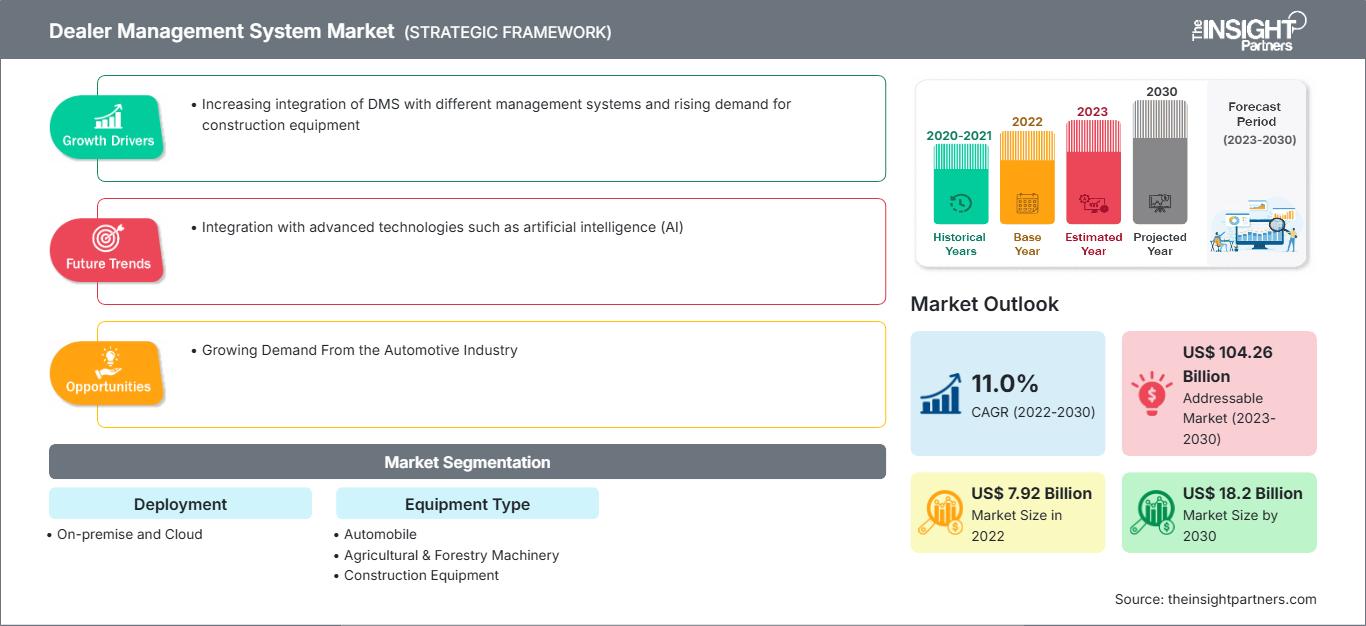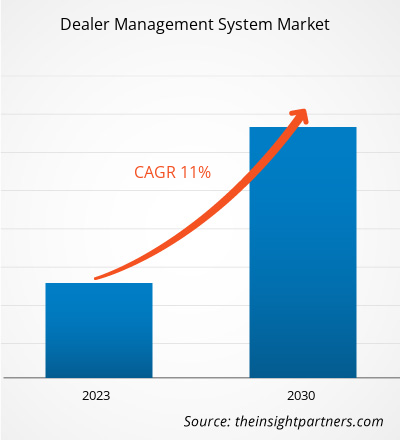预计到 2030 年,经销商管理系统市场规模将从 2022 年的 79.2 亿美元增至 182 亿美元。预计该市场在 2022 年至 2030 年期间的复合年增长率为 11%。与人工智能 (AI) 等先进技术的融合可能仍将是市场的主要趋势。
经销商管理系统市场分析
随着经销商管理系统需求的增加,加上市场进入门槛较低,市场不断见证新兴参与者数量的增长。这些市场参与者正在建立合作伙伴关系,以开发先进的解决方案或为现有系统添加功能,以吸引更多客户。例如,2022 年 12 月,Dealer-Pay 和 Dealertrack 合作,为汽车经销商管理系统添加了先进的支付工具。Dealer-Pay 先进的支付工具已与 Dealertrack 的经销商管理系统集成,使汽车经销商能够处理所有部门的付款。先进的系统通过短信、电子邮件或其他在线平台中的链接向客户付款,提供了灵活性和便利性。对客户满意度提升的日益重视,也推动了经销商管理系统的不断发展。考虑到客户流失的风险,最终用户越来越注重在现有系统中采购和部署先进技术,以通过顺畅地管理采购流程来提升客户满意度。所有这些因素预计将在未来几年推动经销商管理系统市场的增长。
经销商管理系统市场概览
不断发展的技术和不断变化的市场需求,使得企业必须提高其业务各个方面的效率。经销商管理系统简化了经销商网络、销售和客户跟踪、产品订单以及库存管理。经销商管理系统生态系统的主要利益相关者包括软件提供商、系统集成商和最终用户。随着云技术的进步,系统集成商还将本地IT系统与云应用程序相结合。供应商提供的软件是根据最终用户(包括销售汽车的汽车经销商)的特定需求进行集成的。汽车经销商与汽车制造商截然不同,大多独立于汽车制造商。他们采购该系统是为了实时追踪库存并维护与客户的关系,从而高效地运营业务。
经销商管理系统市场碎片化严重。市场参与者正在通过各种方式拓展业务,例如扩展产品组合、扩展服务以及并购 (M&A)。2023 年 5 月,e-Emphasys Technologies Inc. 宣布与 CDK Global Heavy Equipment 合并,以满足设备经销商和租赁公司的端到端业务优化需求。此次合并也有助于该公司推动行业创新。
自定义此报告以满足您的要求
您将免费获得任何报告的定制,包括本报告的部分内容,或国家级分析、Excel 数据包,以及为初创企业和大学提供超值优惠和折扣
经销商管理系统市场: 战略洞察

-
获取本报告的主要市场趋势。这个免费样本将包括数据分析,从市场趋势到估计和预测。
经销商管理系统 (DMS) 市场驱动力与机遇
DMS 与不同管理系统集成度提升,利好市场
工作场所、个人和管理中心之间的同步挑战在处理多项业务(例如提交报告、满足高要求客户的需求以及维护库存)时可能造成巨大挑战。随着对改善客户联系和沟通的日益重视,许多制造商正在寻求集成式业务管理方式。这推动了对能够简化客户、经销商和原始设备制造商 (OEM) 之间互动的系统的需求。集成了客户关系管理 (CRM)、服务管理、备件管理、销售跟踪和库存管理等各种功能的经销商管理系统,能够满足现代制造业日益增长的需求。经销商管理系统收集有关客户、库存和产品的数据,并提高库存管理效率。这些系统有助于了解不同国家/地区的经销商运营情况。各公司正在广泛地将其服务与经销商管理系统集成,以提供增强的客户体验。以下列举了一些此类实例:
- 2022 年 6 月,ABCoA Inc. 推出了革命性的全新 DST 经销商销售工具,用于管理库存。这是一款基于浏览器的全新经销商管理软件 (DMS),专为二手车零售经销商设计。该软件可帮助汽车经销商轻松管理库存、在网站上推广汽车、获得即时融资和桌面交易、进行信用交易以及打印合同。DST 免费提供许多标准集成。此外,该软件还能帮助汽车经销商为客户提供完整的在线购物体验。DST 经销商销售工具易于使用且价格合理,为汽车经销商降低了前期成本,从而增加了市场需求。
借助与不同管理系统集成的强大经销商管理系统,经销商可以管理从库存管理到客户、从产品销售到服务的全方位运营。这一因素正在推动全球经销商管理系统市场的发展。
汽车行业需求不断增长
汽车行业的经销商管理系统提供了全面的解决方案,可高效处理库存、销售、客户关系和业务流程。汽车行业的经销商管理系统可以简化运营,吸引目标受众,培养客户忠诚度,从而取得持续成功。此外,未来几年将是自动驾驶和联网汽车的时代。随着传感器、物联网和机器学习的进步,经销商管理系统可以通过传感器提供车辆的详细信息,包括实际行驶里程、行驶公里数、车辆性能、问题(如有)等。
经销商管理系统市场报告细分分析
促成经销商管理系统市场分析的关键细分是部署和设备类型。
- 根据部署,经销商管理系统市场分为本地部署和云端部署。云计算领域将在 2022 年占据相当大的市场份额。
- 就设备类型而言,市场细分为汽车、农业和林业机械、建筑设备、园艺设备、重型卡车、物料搬运和起重设备、采矿设备等。汽车领域在 2022 年占据了相当大的市场份额。
经销商管理系统市场份额按地域分析
经销商管理系统市场报告的地理范围主要分为五个区域:北美、亚太地区、欧洲、中东和非洲以及南美和中美洲。
亚太地区的经销商管理系统市场正在经历显著增长。亚太地区经销商管理系统市场细分为澳大利亚、中国、印度、日本、韩国和亚太地区其他地区。预计在预测期内,亚太地区将在经销商管理系统市场中录得最高的复合年增长率。亚太地区的市场增长归因于对有效管理业务运营的需求日益增长。跨行业运营的企业,包括运输物流、建筑、农业等,更青睐易于集成、管理和操作的经销商管理系统。此外,基于云的经销商管理系统在该地区越来越受欢迎,因为它对企业有利。例如,2022年12月,塔塔汽车将经销商管理软件迁移到甲骨文云基础设施 (OCI)。该云系统通过详细的业务洞察帮助塔塔汽车提升运营效率。该系统支持汽车经销商增强安全性、提高灵活性,并为客户提供经济高效的解决方案。此外,该系统还帮助公司记录客户接触点,并通过短信和社交媒体等渠道与他们互动,从而提高整体生产力。Hinduja Tech Partners 等多家公司正在建立合作伙伴关系,以提供对运营流程的实时观察。当汽车制造商收到与客户投诉、产品处理和销售相关的问题时,此功能会向他们发出警报。该系统帮助他们立即响应客户的疑问。因此,在各个行业中使用经销商管理系统的好处推动了亚太地区经销商管理系统市场的发展。
经销商管理系统市场区域洞察
The Insight Partners 的分析师已详尽阐述了预测期内影响经销商管理系统市场的区域趋势和因素。本节还讨论了北美、欧洲、亚太地区、中东和非洲以及南美和中美洲的经销商管理系统市场细分和地域分布。
经销商管理系统市场报告范围
| 报告属性 | 细节 |
|---|---|
| 市场规模 2022 | US$ 7.92 Billion |
| 市场规模 2030 | US$ 18.2 Billion |
| 全球复合年增长率 (2022 - 2030) | 11.0% |
| 历史数据 | 2020-2021 |
| 预测期 | 2023-2030 |
| 涵盖的领域 |
By 部署
|
| 覆盖地区和国家 |
北美
|
| 市场领导者和主要公司简介 |
|
经销商管理系统市场参与者密度:了解其对业务动态的影响
经销商管理系统市场正在快速增长,这得益于终端用户需求的不断增长,而这些需求的驱动因素包括消费者偏好的不断变化、技术进步以及对产品优势的认知度不断提高。随着需求的增长,企业正在扩展其产品线,不断创新以满足消费者需求,并利用新兴趋势,从而进一步推动市场增长。

- 获取 经销商管理系统市场 主要参与者概述
经销商管理系统市场新闻及最新发展
经销商管理系统市场评估通过收集一手和二手研究后的定性和定量数据进行,这些数据包括重要的公司出版物、协会数据和数据库。以下列出了经销商管理系统市场的一些发展:
- 领先的重型商用车经销商管理系统 (DMS) 和解决方案提供商 Procede Software 今日宣布正式发布最新版本的 Excede v10.4。新版本是与参与 Procede Insider 计划的 Excede 日常用户和主题专家密切合作开发的,该计划是其以用户为中心的设计战略的基石。(来源:Procede Software,新闻稿,2024 年 1 月)
- DealerBox SAS 与 Electric Way 合作,管理汽车的交付流程。DealerBox SAS 的汽车云解决方案帮助 Electric Way 处理汽车的采购、销售、注册和运输等内部流程。 (来源:DealerBox SAS, Ltd,新闻稿,2023 年 6 月)
经销商管理系统市场报告覆盖范围和交付成果
“经销商管理系统市场规模和预测(2020 年–2030 年)”报告提供了涵盖以下领域的市场详细分析:
- 经销商管理系统市场规模以及涵盖范围内所有关键细分市场的全球、区域和国家/地区预测
- 经销商管理系统市场趋势以及市场动态,例如驱动因素、限制因素和关键机遇
- 详细的 PEST/波特五力模型和 SWOT 分析
- 经销商管理系统市场分析涵盖关键市场趋势、全球和区域框架、主要参与者、法规和最新市场发展
- 行业格局和竞争分析涵盖市场集中度、热图分析、知名参与者以及经销商管理系统市场的最新发展
- 详细的公司简介
- 历史分析(2 年)、基准年、预测(7 年)及复合年增长率
- PEST和SWOT分析
- 市场规模、价值/数量 - 全球、区域、国家
- 行业和竞争格局
- Excel 数据集
近期报告
相关报告
客户评价
购买理由
- 明智的决策
- 了解市场动态
- 竞争分析
- 客户洞察
- 市场预测
- 风险规避
- 战略规划
- 投资论证
- 识别新兴市场
- 优化营销策略
- 提升运营效率
- 顺应监管趋势






















 获取免费样品 - 经销商管理系统市场
获取免费样品 - 经销商管理系统市场